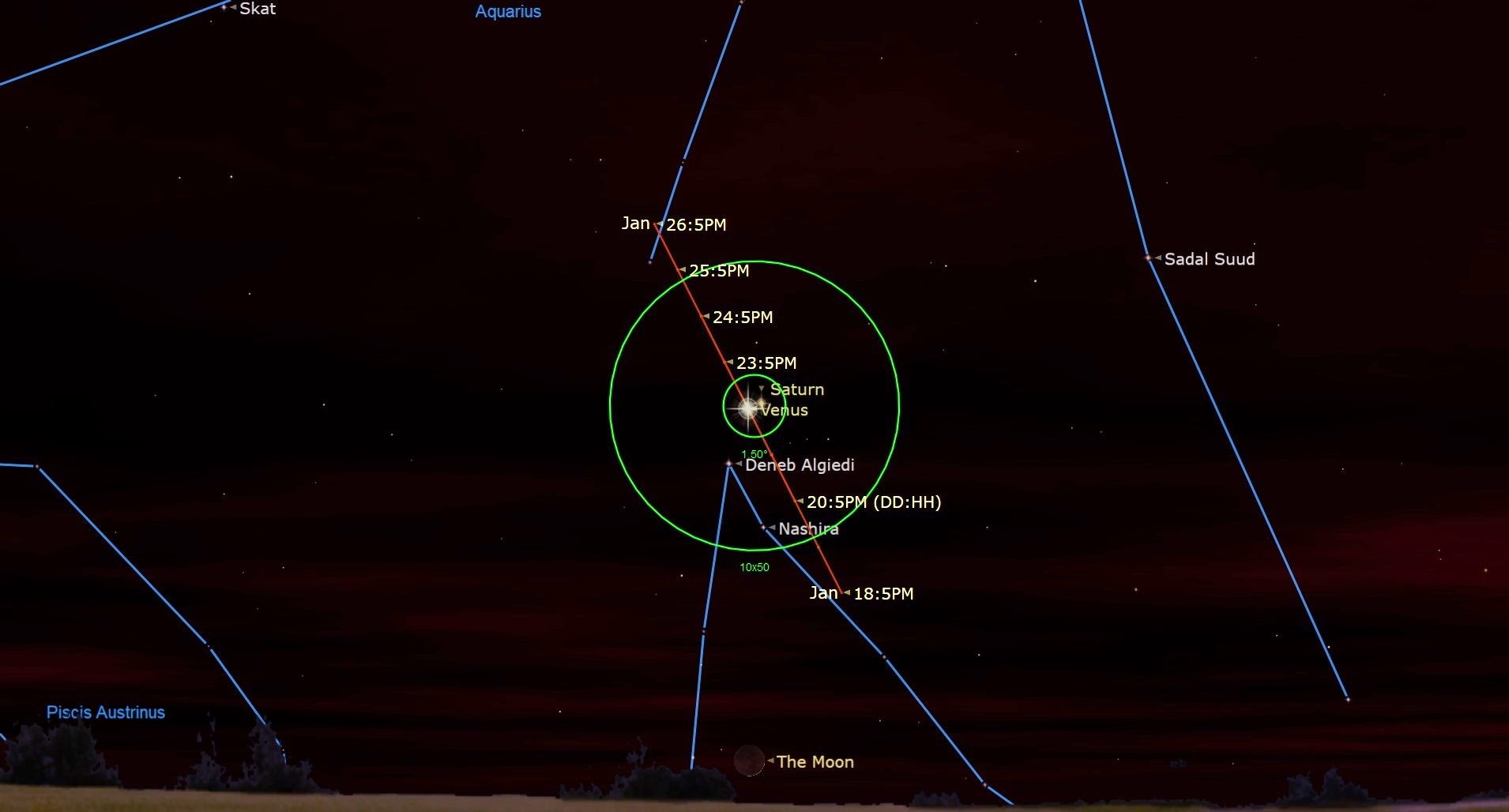What time is the conjunction of Venus and Saturn on Sunday (Jan. 22)?
The two planets will be close enough in the sky to both be seen through a telescope.

This weekend offers a fantastic opportunity to see two of the solar system's planets line up in the night sky.
Venus and Saturn will be in conjunction, meaning they'll share the same right ascension — the equivalent of longitude in the celestial sphere. Shortly after, the two planets will make their closest approach to one another in the sky, an event known as an appulse.
The conjunction of Venus and Saturn will take place on Sunday (Jan. 22) at 2:36 p.m. EST (1936 GMT), according to In-the-Sky.org. The pair should become visible from New York City around 5:18 p.m. just as darkness falls, shortly after the two make their close approach, or appulse, around 5:13 p.m. EST (2213 GMT). You can watch the Venus and Saturn conjunction in a free webcast at 1:30 p.m. EST (1830 GMT) from the Virtual Telescope Project.
If you don't have good viewing conditions in your area, you can still watch the event live thanks to a free webcast hosted by the Virtual Telescope Project. The livestream will start on Sunday (Jan. 22) at 11:00 a.m. EST (1600 GMT) and can be streamed via the project's website or YouTube channel.
Related: See Venus and Saturn snuggle in the sky Sunday (Jan. 22)
Interference from the moon should be minimal following January's new moon on Saturday (Jan. 21). By Sunday evening, the moon will only be a 2% illuminated crescent.
The pair will be in the night sky just eight degrees below the moon on Sunday evening — just under the width of your clenched fist at arm's length when held up to the sky. Venus should appear as a bright but small, featureless disk with a magnitude of around -3.9, indicating a fairly bright object. Venus will continue to rise in the night sky over the coming months and will become brighter throughout spring.
Get the Space.com Newsletter
Breaking space news, the latest updates on rocket launches, skywatching events and more!

Want to get a closer look at Venus and Saturn? We recommend the Celestron Astro Fi 102 as the top pick in our best beginner's telescope guide.
Meanwhile, Saturn will be significantly less bright on Sunday at magnitude +0.8, but its rings should be visible with even a low-powered telescope or binoculars. Saturn is moving in the opposite direction as Venus, currently sinking lower in the sky each night. By Feb. 16, Saturn will be totally unobservable as it enters solar conjunction, meaning it will be on the opposite side of Earth from the sun and will be obscured from view by the light of our star.
Though Venus and Saturn will appear close together in the sky from our vantage point on Earth on Sunday, the pair will actually remain separated by quite a distance. While their positions relative to one another change as they orbit our star, Saturn is currently some 914 million miles (1.4 billion kilometers) from the sun, while Venus is 68 million miles (109 million km) away, according to NASA.
If you don't have all the gear you need to see the conjunction of Venus and Saturn, our guides on the best telescopes and best binoculars are a great place to begin. If you're looking to snap photos of the event or anything else in the night sky, check out our guides on the best cameras for astrophotography and best lenses for astrophotography.
Editor's Note: If you get a great photo of the close approach or conjunction between Venus and Saturn and would like to share it with Space.com's readers, send your photo(s), comments, and your name and location to spacephotos@space.com.
Follow Brett on Twitter at @bretttingley. Follow us @Spacedotcom, or on Facebook and Instagram.
Join our Space Forums to keep talking space on the latest missions, night sky and more! And if you have a news tip, correction or comment, let us know at: community@space.com.

Brett is curious about emerging aerospace technologies, alternative launch concepts, military space developments and uncrewed aircraft systems. Brett's work has appeared on Scientific American, The War Zone, Popular Science, the History Channel, Science Discovery and more. Brett has English degrees from Clemson University and the University of North Carolina at Charlotte. In his free time, Brett enjoys skywatching throughout the dark skies of the Appalachian mountains.









